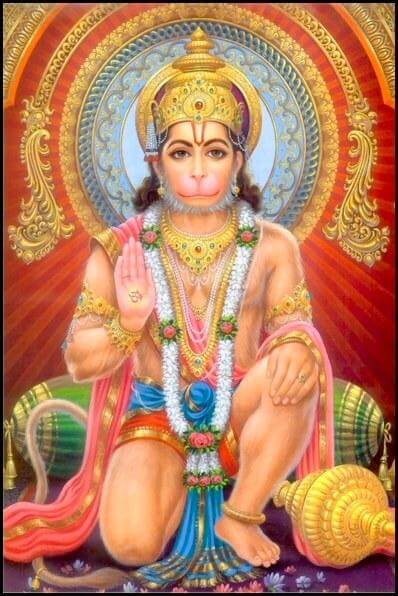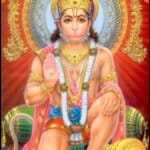Hanuman Jayanti, a festival celebrating the birth of Lord Hanuman, is among the most cherished occasions in Hinduism.
It is observed with profound devotion and religious fervor by followers throughout India.
In 2025, Hanuman Jayanti will be celebrated on Saturday, April 12.
On this holy day, devotees pay tribute to the Vanara God, renowned for his unwavering dedication to Lord Rama, remarkable strength, humility, and his service to humanity.
Let’s explore the importance of Hanuman Jayanti, the traditions followed on this day, and how individuals can spiritually connect with Lord Hanuman through worship and prayers.

Who is Lord Hanuman?
Lord Hanuman, also known as Anjaneya, Bajrangbali, or Maruti, is view as an incarnation of Lord Shiva and the offspring of Anjana and Kesari.
He is also recognize as the son of Vayu, the wind god, who is believed to have played a significant role in Hanuman’s birth.
Hanuman represents devotion (bhakti), bravery, strength, selfless service, and humility.
His steadfast devotion to Lord Rama and his involvement in the epic Ramayana have established him as a beloved deity for many.
Furthermore, he is believed to be Chiranjeevi, which means immortal, and he is to continue to exist among us, particularly where the name of Lord Rama is uttered.
Hanuman Jayanti 2025 Date and Tithi
Date: Saturday, April 12, 2025
Tithi: Chaitra Shukla Purnima (Full Moon Day of the Chaitra month)
Purnima Tithi Begins: April 11, 2025, at 09:58 PM
Purnima Tithi Ends: April 12, 2025, at 11:17 PM
This occasion is observe during the Chaitra Shukla Purnima, and in certain regions of India, particularly in southern states like Karnataka and Tamil Nadu.
Hanuman Jayanti is celebrate on alternate dates such as Margashirsha Amavasya or Vaishakha Krishna Paksha, depending on local customs.

Importance of Hanuman Jayanti
Emblem of Strength and Devotion
Hanuman Jayanti signifies the divine manifestation of Lord Hanuman, who embodies strength, valor, and unwavering devotion.
His life motivates devotees to surmount challenges, remain modest, and adhere faithfully to dharma.
Model for Bhakti and Karma Yoga
Hanuman is regarde as the ideal fusion of Bhakti Yoga (the path of devotion) and Karma Yoga (the path of selfless action).
His affection for Rama and relentless service serve as a guiding example for all spiritual seekers.
Safeguard against Negative Forces
Hanuman is recognize as a powerful guardian who dispels malevolent spirits, negative energies, and planetary doshas such as Shani Dosh.
Reciting the Hanuman Chalisa or his mantras on Hanuman Jayanti is believe to provide strength, security, and tranquility.
Hanuman Jayanti Pooja Customs
Early Morning Bath and Sankalp
Devotees commence the day with a sacred bath and don fresh garments.
Following purification, they undertake a sankalp (commitment) to observe the day with devotion and adhere to vrat (fasting) and pooja rituals.
Cleanse the Puja Area and Install Hanuman Idol
The worship area is tidied and adorned with flowers and rangoli.
An idol or image of Lord Hanuman is place on a red fabric.
The idol is then consecrate with sindoor (vermilion) and charnamrit (holy water).
Offerings to Lord Hanuman
Devotees present items cherished by Hanuman, such as:
Red flowers (especially hibiscus)
Sindoor blended with jasmine oil
Boondi or besan laddoo
Bananas and jaggery
Tulsi leaves (optional)
Coconut and incense
Recitation of Hanuman Mantras and Stotras
Chanting Hanuman’s names and mantras is a central aspect of the worship.
Some frequently recited prayers include:
Hanuman Chalisa
Sundar Kand from Ramcharitmanas
Anjaneya Dandakam (in South India)
Lighting Lamps and Aarti
Devotees ignite ghee lamps or camphor during the Hanuman Aarti.
Singing devotional bhajans and performing the aarti with full attention invokes divine blessings.
Fasting and Charity
Many people observe a strict fast or consume only fruits and milk.
Devotees also engage in daan (charity) by distributing food, clothing, and Hanuman Chalisa booklets to the needy.
Visiting Hanuman Temples
Devotees flock to Hanuman temples for special darshan, bhajan-kirtan, and prasad distribution.
Some temples hold Akhand Ramayan Paath or Sankirtan that lasts all day and night.
Spiritual Practices for Hanuman Jayanti
Reciting 108 Names of Hanuman Devotees often chant the 108 names to call upon his diverse attributes such as Ramabhakta, Sankatmochan, Mahaveer, and more.
Applying Sindoor Smearing sindoor on Hanuman’s idol represents strength and divine blessings.
It is said that Lord Hanuman applies sindoor on himself for the longevity of Lord Rama.
Reading the Ramayana or Sundar Kand Reciting passages from the Ramayana.
Particularly the Sundar Kand, where Hanuman’s devotion and bravery are highlighted, is considered extremely auspicious.
Night Vigil (Jagran) Staying awake throughout the night of Hanuman Jayanti while singing bhajans and reciting the Hanuman Chalisa is a common ritual in many regions.
Things to Remember on Hanuman Jayanti
- Purity of Mind and Body: Maintain personal hygiene and a serene, positive mindset throughout the day.
- Avoid Non-Vegetarian Food & Alcohol: Abstain from eating meat, consuming alcohol, or eating onion and garlic on this holy day.
- Stay Humble and Disciplined: Hanuman epitomizes humility and discipline, so refrain from arrogance or negative conduct.
- Observe Silence or Speak Thoughtfully: Limit unnecessary conversations and focus on reciting Hanuman’s mantras or bhajans.
- Read or Listen to Sundar Kand or Ramayana: Engaging with these texts brings spiritual benefits and blessings from Lord Rama and Hanuman.
- Avoid Cutting Nails or Hair: Generally, such activities are avoid during fasting and sacred observances.
- Visit Temples Respectfully: If you plan to visit a temple, do so with respect and engage in communal prayers or chanting.
By adhering to these simple practices, one can connect with the true spiritual spirit of Hanuman Jayanti and receive the divine grace of Lord Hanuman.

Advantages of Worshiping Hanuman on this Day
- Courage and Mental Fortitude: Regularly chanting the Hanuman Chalisa dispels fear, anxiety, and stress.
- Protection from Malevolence: He shields followers from black magic, malevolent spirits, and adverse influences.
- Health and Vitality: Worshiping Hanuman enhances physical strength and vigor.
- Success in Academics and Careers: Students and professionals seek Hanuman’s blessings for concentration and achievement.
- Alleviation from Planetary Doshas: Particularly Shani Dosh and Mangal Dosh are mitigate through Hanuman’s divine blessings.
Hanuman Jayanti Celebrations Throughout India
Uttar Pradesh & North India: Grand processions featuring Hanuman’s idol, satsangs, and offering of prasad.
Maharashtra: Devotees chant Hanuman Chalisa 108 times or take part in group chanting sessions.
Tamil Nadu & Karnataka: Celebrated on varying dates, often during Margashirsha or Vaishakha, incorporating special rituals and illuminated Anjaneya temples.
Andhra Pradesh & Telangana: Engaging in the recitation of the Sundar Kand and spiritual teachings.
Conclusion
Hanuman Jayanti 2025 is not merely a celebration but a chance for spiritual awakening, inner strength, devotion, and selfless service.
Whether through chanting the Hanuman Chalisa, visiting temples, or simply invoking his name with faith, devotees can gain tranquility, protection, and divine grace.
May this Hanuman Jayanti bring you an abundance of courage, wisdom, and devotion.
Jai Bajrangbali!
- Top 10 Study Apps That Actually Help You Learn Better
- Gupt Navratri Day 7: सातवे दिन करें मां कालरात्रि का पूजन | पढ़े विधि व कथा
- Sawan Somvar Vrat Katha: पढ़े सावन सोमवार व्रत की कथा व शिव आरती
- Gupt Navratri Day 6: छठे दिन करें मां कात्यायनी का पूजन, नोट करें विधि व कथा
- Durga Saptshati (Sanskrit): पढ़े दुर्गा सप्तशती का चौथा अध्याय








